Praetorians Q&A
We talk to Javier Arevalo from Pyro Studios to learn more about the upcoming real-time strategy game from the creators of Commandos.
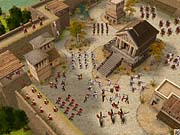
The developers at Pyro Studios, creators of the Commandos series, are currently working on a real-time strategy game named Praetorians, which is set within an age when the Roman Empire was at the peak of its power, spreading its influence across Europe and Northern Africa. However, Pyro Studios plans to take a slightly different approach with Praetorians by not emphasizing resource management but rather by placing the focus on combat and specific tactics. Moreover, each of the three civilizations in the game has different attributes and a wide array of battle tactics that can give them a distinct advantage in certain situations. We spoke with Javier Arevalo, project leader for Praetorians, and asked why the development team wanted to stay away from a complex resource system, how the AI will react in battle, and what kind of multiplayer features are planned for the final release.
GameSpot: Tell us a little about the team working on Praetorians.
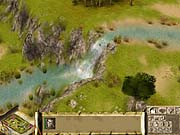
Javier Arevalo: The team that has worked on the project so far is composed [of] four graphics artists, five programmers, one designer, and [me] as project lead. Three of us worked on all the Commandos games before moving to Praetorians; for several members this is the first big project. In its final development phase the team will have grown to over 35 people.
GS: Why did you choose the Roman Empire as the backdrop for a real-time strategy game?
JA: The Roman Empire has proven its attractiveness in countless movies and books. It has already been the source of inspiration for many games, but most of them centered [on] the economic aspect and politics of city and empire building. We already thought that the Roman military campaigns were a huge and untapped area for gaming, but we were awed by what we found while doing research on armies and battles for the game. We want to convey some of that epic feeling to game players, while at the same time making it immediately accessible.
GS: Will players be able to choose from civilizations other than the Roman Empire?
JA: There are three distinct civilizations in the game: Romans, Barbarians and Egyptians. Barbarians are designed as a mixture of different European tribes (Gauls, Germanics, Celts) and are found during missions in Central and Northern Europe. Egyptians will be encountered once the player moves to the north of Africa. As the single-player story and missions unfold, the player will have to fight against them, and sometimes even ally with them to fight his or her own rebellions.
All these civilizations will be selectable for multiplayer games.
GS: What are the differences between these civilizations?
JA: Roman forces base their strength on strict discipline and organization. As such, their troops move perfectly ordered and are able to perform special maneuvers and formations. Barbarians are stronger, faster, less numerous and more disorganized. Egyptians are more flexible in both respects, since their culture was a tight mixture of political and military power, and religious fanaticism.
GS: Are there unique campaigns for each civilization?
JA: There are essentially three campaigns: one within the Roman Empire, one in Central and Northern Europe, and one in Egypt. However, missions will be intermixed following a storyline.
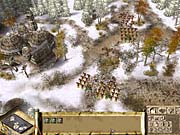
GS: How would you describe the gameplay? Is Praetorians more of a traditional real-time strategy game or does it take a somewhat different approach?
JA: The game is centered [on] strategy and combat tactics. The player is given a small army in the beginning of a mission, and he must fight to complete the mission goal and subgoals.
Praetorians also sports fortress sieges like no other strategy has attempted before, with the ability to either destroy the gates and rush inside the fortress or use ladders and assault towers to gain access to the high ground of perimeter walls and fight there.
The simplified resource model has the player seize control of small villages scattered throughout the map and using military chiefs in order to recruit villagers and train new troops. This is the way the player can replenish his army or adjust his army's composition to his preference.
GS: In the case of Praetorians, why has there been such a strong effort to de-emphasize resource management?
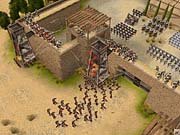
JA: We want to emphasize the military aspects, and we found that having to take care of your farms and cities in the middle of a battle is too distracting for our gameplay style. Also, with a complex resource system, games usually become races for the economic battle, not the military one: He who has the biggest army sooner, wins. That's why we have simplified the resource model to its bare bones: being able to produce new units. Praetorians does not invalidate the style of more common RTS games but attempts to provide a new experience, focused on combat..
GS: How will players receive new units and unit upgrades?
JA: Units and military chiefs gain experience when they fight, and this experience provides better armor and combat abilities. We also have the option of putting our military chiefs in control of troops, enhancing them and giving them access to some of the special abilities and formations.
GS: How many different types of units are there, and how specialized are unit abilities?
JA: The units are modeled after real-world army units; however, we have exaggerated their features and taken them to an extreme to ensure the gameplay is intense and fun. Some units are very powerful against others, like pikemen against cavalry or heavy infantry against archers, but they all have their weaknesses. Our goal is to ensure that no inflexible tactic is a surefire winner.
This idea extends to special formations and abilities. Every unit type has one or several special abilities, designed after the style of their races. For example, Romans have advanced formations and weapon types, while Barbarians have terror-inducing war cries and skirmish-oriented abilities.
We are working hard to guarantee that units and their strengths and weaknesses are instantly recognizable, so players can quickly be in control of the game and concentrate on learning the subtleties of the gameplay and missions.
GS: Will players be able to use contemporary battle tactics like turtling?
JA: Definitely, we have put actual Roman tactics into the game as special abilities; heavy infantry can perform the heavily defensive turtle formation, pikemen can plant a knee on the ground to receive cavalry charges, archers can use fire arrows to burn villages or war machines.

GS: The graphic engine looks very impressive--how many onscreen units can it support at once?
JA: Playing a full-scale multiplayer game with eight players--the total unit count gets into several thousand units in the same game; let's hope not all of them are battling in the same place. Seriously, we haven't done a final balance of unit numbers for our target machine, but each player will be in control of a few hundred units. Controlling such a huge number is simple, thanks to the fact that they are grouped in troops.
GS: What kind of environments do you plan on including in Praetorians? Will they have any affect on gameplay, such as tactical height advantages?
JA: Terrain plays a big factor in deciding the best approach for a battle or skirmish. Archers and war machines placed on high ground get longer range and are obscured from the line of sight of lower-ground units. This opens opportunities for ambushes. Many units can also hide in forests and launch attack from there, but, for example, cavalry and war machines cannot. Some units can cross low-water sections of a river while others need a bridge...there are many possibilities that we're still exploring to exploit all the strategic possibilities the terrain offers.
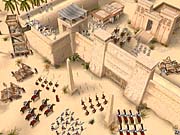
GS: How dynamic is the AI? Will it be able to exploit weaknesses in an enemy's defense or seize advantages when they present themselves?
JA: The AI understands the importance of terrain and the enemy units; it can find the best plan to attack the player depending on the units the player uses. It will wait to gather the right army before launching attacks and even retire to more secure positions if it's being overwhelmed.
GS: Are there plans to include different multiplayer modes? How many players will the multiplayer mode support?
JA: We're supporting up to eight players in an online game, Internet or LAN. Multiplayer game types are actually very similar to other real-time strategy games, although we want to place emphasis on team battles: Having three players control a fortress' defenses while the other three attack simultaneously is quite a sight!
We're considering the possibility of allowing spectators to watch a game as it progresses, but we'll have to see how well it works with the low-end Internet connections available to the wide audience, as well as ways to prevent cheating.
GS: When do you expect Praetorians to be complete?
JA: We're at least one year from completion; we will have a more precise date depending on how fast we progress on unit and mission balance.
GS: Thanks, Javier.
Got a news tip or want to contact us directly? Email news@gamespot.com
Join the conversation